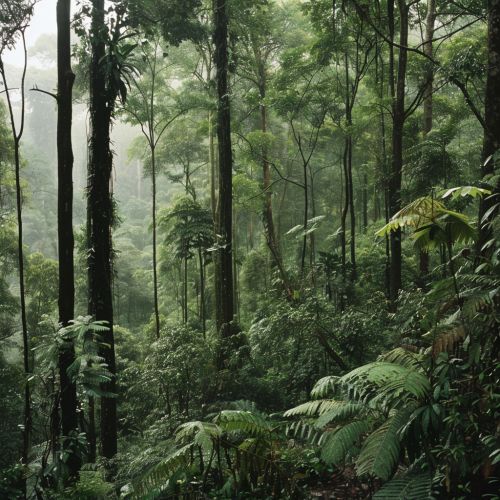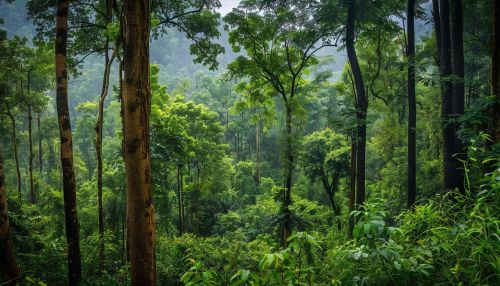Monsoon Forests
Introduction
Monsoon forests, also known as tropical deciduous forests, are a type of forest ecosystem characterized by seasonal rainfall patterns. These forests are predominantly found in regions with a distinct monsoon climate, which includes a wet season with heavy rainfall and a dry season with little to no precipitation. Monsoon forests are primarily located in South and Southeast Asia, parts of Africa, Central and South America, and northern Australia.
Climate and Geography
Monsoon forests thrive in regions with a tropical monsoon climate, which is classified under the Köppen climate classification as Am or Aw. These regions experience a significant amount of rainfall during the wet season, typically ranging from 1,000 to 2,500 millimeters annually. The dry season, on the other hand, can last for several months, during which the forest receives minimal precipitation.
The geographical distribution of monsoon forests is influenced by the presence of the Intertropical Convergence Zone (ITCZ), which shifts seasonally and brings heavy rains to these regions. The ITCZ is a belt of low pressure that encircles the Earth near the equator, where the trade winds of the Northern and Southern Hemispheres converge.
Vegetation
Monsoon forests are characterized by a diverse range of plant species that have adapted to the seasonal variations in rainfall. The vegetation in these forests can be broadly classified into three layers: the canopy, the understory, and the forest floor.
Canopy
The canopy layer is composed of tall, deciduous trees that shed their leaves during the dry season to conserve water. Common tree species found in the canopy include teak (Tectona grandis), sal (Shorea robusta), and sandalwood (Santalum album). These trees can reach heights of up to 30 meters and form a dense cover that provides shade and habitat for various animal species.
Understory
The understory layer consists of smaller trees, shrubs, and lianas that thrive in the shaded environment beneath the canopy. This layer is home to species such as bamboo, which can grow rapidly during the wet season, and various types of palms. The understory also supports a rich diversity of epiphytes, including orchids and ferns, which grow on the trunks and branches of larger trees.
Forest Floor
The forest floor is covered with a thick layer of leaf litter, decomposing organic matter, and a variety of herbaceous plants. This layer plays a crucial role in nutrient cycling and supports a diverse community of decomposers, such as fungi, bacteria, and invertebrates. The forest floor is also home to various ground-dwelling animals, including insects, reptiles, and small mammals.


Fauna
Monsoon forests support a wide range of animal species, many of which have adapted to the seasonal changes in their environment. The fauna in these forests includes large mammals, birds, reptiles, amphibians, and a diverse array of invertebrates.
Mammals
Large mammals such as the Asian elephant (Elephas maximus), Bengal tiger (Panthera tigris tigris), and Indian rhinoceros (Rhinoceros unicornis) are commonly found in monsoon forests. These animals rely on the abundant food resources available during the wet season and often migrate to other areas during the dry season in search of water and forage.
Birds
Monsoon forests are home to a rich diversity of bird species, including both resident and migratory birds. Notable species include the Indian peafowl (Pavo cristatus), the great hornbill (Buceros bicornis), and various species of kingfishers and parrots. These birds play important roles in seed dispersal and pollination, contributing to the overall health and regeneration of the forest.
Reptiles and Amphibians
Reptiles such as the Indian python (Python molurus), monitor lizards, and various species of geckos and skinks are commonly found in monsoon forests. Amphibians, including frogs and toads, are also abundant, particularly during the wet season when temporary pools and streams provide ideal breeding habitats.
Invertebrates
Invertebrates, including insects, spiders, and mollusks, form a significant component of the monsoon forest ecosystem. These organisms play crucial roles in pollination, decomposition, and as a food source for other animals. Notable invertebrates include various species of butterflies, beetles, ants, and termites.
Ecological Importance
Monsoon forests play a vital role in maintaining ecological balance and supporting biodiversity. They provide habitat for a wide range of plant and animal species, many of which are endemic and cannot be found elsewhere. These forests also contribute to important ecological processes such as nutrient cycling, soil formation, and water regulation.
Carbon Sequestration
Monsoon forests act as significant carbon sinks, absorbing carbon dioxide from the atmosphere and storing it in biomass and soil. This process helps mitigate the effects of climate change by reducing the concentration of greenhouse gases in the atmosphere.
Hydrological Cycle
The dense vegetation in monsoon forests plays a crucial role in regulating the hydrological cycle. The forest canopy intercepts rainfall, reducing the impact of heavy rains on the soil and minimizing erosion. The root systems of trees and other plants help to stabilize the soil and promote water infiltration, which replenishes groundwater reserves.
Soil Fertility
The decomposition of leaf litter and organic matter on the forest floor contributes to the formation of rich, fertile soils. These soils support the growth of diverse plant species and provide essential nutrients for agricultural activities in surrounding areas.
Human Impact
Monsoon forests have been significantly impacted by human activities, including deforestation, agriculture, and urbanization. These activities have led to habitat loss, fragmentation, and degradation, threatening the biodiversity and ecological functions of these forests.
Deforestation
Deforestation for timber, fuelwood, and agricultural expansion is one of the primary threats to monsoon forests. The removal of trees disrupts the forest structure, reduces habitat availability for wildlife, and contributes to soil erosion and loss of soil fertility.
Agriculture
Shifting cultivation, also known as slash-and-burn agriculture, is a common practice in many regions with monsoon forests. This method involves clearing patches of forest for crop cultivation and then abandoning the land after a few years of use. While this practice can be sustainable at low population densities, it often leads to large-scale deforestation and soil degradation when practiced extensively.
Urbanization
Rapid urbanization and infrastructure development have also contributed to the loss of monsoon forests. The construction of roads, dams, and other infrastructure projects often requires the clearing of large areas of forest, leading to habitat fragmentation and disruption of ecological processes.
Conservation Efforts
Efforts to conserve monsoon forests focus on protecting remaining forest areas, restoring degraded landscapes, and promoting sustainable land-use practices. These efforts involve collaboration between governments, non-governmental organizations, local communities, and international agencies.
Protected Areas
Establishing protected areas, such as national parks and wildlife sanctuaries, is a key strategy for conserving monsoon forests. These areas provide legal protection for forests and their biodiversity, preventing activities such as logging, hunting, and land conversion.
Community-Based Conservation
Engaging local communities in conservation efforts is essential for the long-term success of monsoon forest conservation. Community-based conservation initiatives involve empowering local people to manage and protect their natural resources, often through the establishment of community forests and the promotion of sustainable livelihoods.
Restoration and Reforestation
Restoration and reforestation projects aim to rehabilitate degraded monsoon forests by planting native tree species and promoting natural regeneration. These projects help to restore ecosystem functions, enhance biodiversity, and provide benefits such as carbon sequestration and improved water quality.
Conclusion
Monsoon forests are a unique and vital component of the Earth's tropical ecosystems. They support a rich diversity of plant and animal species, contribute to important ecological processes, and provide valuable resources for human communities. However, these forests face significant threats from human activities, and concerted efforts are needed to conserve and restore them for future generations.
